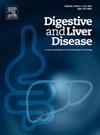tips后穿刺作为肝移植的预测因素:竞争风险分析
IF 3.8
3区 医学
Q1 GASTROENTEROLOGY & HEPATOLOGY
引用次数: 0
摘要
背景和目的经颈静脉肝内门静脉系统分流术(TIPS)是治疗肝硬化患者门静脉高压并发症的常用方法。然而,TIPS放置与随后的肝移植(LT)之间的关系仍未被探索,特别是当考虑到死亡是一个竞争结果时。本研究旨在确定可能符合肝移植条件的肝硬化患者置放控制扩张TIPS后肝移植的预测因素。方法我们对2016年至2023年因难治性腹水、静脉曲张出血或门静脉血栓形成而接受控制扩张TIPS置放的肝硬化患者进行了一项队列研究。仅纳入符合移植条件的患者(年龄70岁,无严重肝外合并症)。随访开始于TIPS配售日期。评估与肝脏疾病严重程度、病因和临床特征相关的基线变量,以及TIPS后的临床事件,包括需要大容量穿刺(LVP)的腹水、肝性脑病(HE)、静脉曲张出血发作和TIPS功能障碍。主要结局是肝移植,无肝移植的死亡是一个竞争事件。结果本研究纳入258例患者(平均年龄57.2岁,男性185例,71.7%),因难治性腹水(178例,69.0%)、静脉曲张出血(62例,24.0%)或门静脉血栓形成(18例,7.0%)放置TIPS。TIPS放置前的平均MELD-Na为13.2+4.2。大多数患者(205例,79.5%)接受了直径8mm的TIPS。在中位随访14个月(IQR为4.1-27.6)期间,52例(20.1%)患者在TIPS(0.1-62个月)的中位时间4.7个月后接受了肝移植,49例(19.0%)患者在无肝移植的情况下死亡。竞争风险分析显示,12个月时肝移植的累积发生率函数(ci)为19.3% (95%CI 14.3-25.0), 24个月时为23.3% (95%CI 17.6-29.4%)。12个月时死亡率为14.8% (95%CI 10.3 ~ 20.0%), 24个月时死亡率为21.2% (95%CI 15.6 ~ 27.4%)。植入TIPS后,92例患者(35.6%)发生HE(23例患者中3-4级,8.9%),73例患者(28.3%)发生腹水,需要LVP, 8例患者(3.1%)发生静脉曲张出血,26例患者(10.1%)发生TIPS功能障碍。多变量竞争风险分析确定了LT的三个独立预测因素:TIPS适用于难治性腹水(HR 2.30, 95% CI 1.04-5.07, p=0.039),基线MELD-Na评分(HR 1.11, 95% CI 1.05-1.17, p<0.001), TIPS后腹水需要穿刺(HR 1.83, 95% CI 1.01-3.30, p=0.047)。研究结果表明,基线疾病严重程度和TIPS后临床事件均可预测TIPS受者的LT。顽固性腹水作为TIPS适应症和置放TIPS后LVP的需要与接受lt的高概率独立相关。这些结果为置放TIPS后移植时机的决定提供了有价值的预后信息,强调了即使置放TIPS成功后仍需要继续监测门静脉高压并发症。本文章由计算机程序翻译,如有差异,请以英文原文为准。
Post-TIPS paracentesis as a predictor of liver transplantation: a competing risks analysis
Background&Aims
Transjugular intrahepatic portosystemic shunt (TIPS) is an established treatment for portal hypertension complications in patients with cirrhosis. However, the relationship between TIPS placement and subsequent liver transplantation (LT) remains unexplored, particularly when considering death as a competing outcome. This study aimed to identify predictors of LT following controlled-expansion TIPS placement in patients with cirrhosis potentially eligible to LT.
Methods
We conducted a cohort study in patients with cirrhosis who underwent controlled-expansion TIPS placement for refractory ascites, variceal bleeding, or portal vein thrombosis from 2016 to 2023. Only transplant-eligible patients (age <70 years, absence of severe extrahepatic comorbidities) were included. Follow-up started at TIPS placement date. Baseline variables related to liver disease severity, etiology, and clinical characteristics were assessed, along with post-TIPS clinical events including ascites requiring large-volume paracentesis (LVP), hepatic encephalopathy (HE), variceal bleeding episodes, and TIPS dysfunction. The primary outcome was LT, with death without LT as a competing event. A multivariable competing risk regression model was employed to identify independent predictors of LT.
Result
The study cohort included 258 patients (mean age 57.2 years, male sex n=185, 71.7%) who placed TIPS for refractory ascites (n=178, 69.0%), variceal bleeding (n=62, 24.0%) or portal thrombosis (n=18, 7.0%). Mean MELD-Na before TIPS placement was 13.2+4.2. Most of patients (205, 79.5%) received a 8-mm diameter TIPS. During a median follow-up of 14 months (IQR 4.1-27.6), 52 patients (20.1%) underwent LT after a median time of 4.7 months from TIPS (range 0.1-62 months) and 49 (19.0%) died without LT. Cumulative incidence functions (CIFs) of LT were 19.3% (95%CI 14.3-25.0) at 12 months and 23.3% (95%CI 17.6-29.4%) at 24 months by competing risks analysis. CIFs of death were 14.8% (95%CI 10.3-20.0%) at 12 months and 21.2% (95%CI 15.6-27.4%) at 24 months. After TIPS placement, 92 patients (35.6%) developed HE (grade 3-4 in 23 patients, 8.9%), 73 patients (28.3%) developed ascites requiring LVP, 8 patients (3.1%) developed variceal bleeding and 26 patients (10.1%) developed TIPS dysfunction. Multivariable competing risk analysis identified three independent predictors of LT: TIPS indication for refractory ascites (HR 2.30, 95% CI 1.04-5.07, p=0.039), baseline MELD-Na score (HR 1.11 per point increase, 95% CI 1.05-1.17, p<0.001), and post-TIPS ascites requiring paracentesis (HR 1.83, 95% CI 1.01-3.30, p=0.047).
Conclusions
Our findings demonstrate that both baseline disease severity and post-TIPS clinical events predict LT in TIPS recipients. Refractory ascites as TIPS indication and need for LVP after TIPS placement were independently associated with higher probability of receiving LT. These results provide valuable prognostic information for transplant timing decisions in the post-TIPS setting, emphasizing the need for continued monitoring of portal hypertension complications even after successful TIPS placement.
求助全文
通过发布文献求助,成功后即可免费获取论文全文。
去求助
来源期刊

Digestive and Liver Disease
医学-胃肠肝病学
CiteScore
6.10
自引率
2.20%
发文量
632
审稿时长
19 days
期刊介绍:
Digestive and Liver Disease is an international journal of Gastroenterology and Hepatology. It is the official journal of Italian Association for the Study of the Liver (AISF); Italian Association for the Study of the Pancreas (AISP); Italian Association for Digestive Endoscopy (SIED); Italian Association for Hospital Gastroenterologists and Digestive Endoscopists (AIGO); Italian Society of Gastroenterology (SIGE); Italian Society of Pediatric Gastroenterology and Hepatology (SIGENP) and Italian Group for the Study of Inflammatory Bowel Disease (IG-IBD).
Digestive and Liver Disease publishes papers on basic and clinical research in the field of gastroenterology and hepatology.
Contributions consist of:
Original Papers
Correspondence to the Editor
Editorials, Reviews and Special Articles
Progress Reports
Image of the Month
Congress Proceedings
Symposia and Mini-symposia.
 求助内容:
求助内容: 应助结果提醒方式:
应助结果提醒方式:


